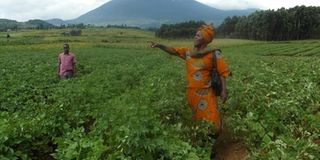With clean seed and good roads, Kigezi farmers smile to the market

An Irish potato farm in Kisoro: Farmers in the Kigezi sub-region stand to benefit from increased access to disease-free seed as well as lucrative markets. FILE PHOTO
Potato farmers in Kigezi region can afford a smile on their faces as the demand for potatoes in Uganda and neighbouring countries is grows, thanks to emerging consumer trends which favour potato-based fast-foods and snacks.
In many urban areas, potato fries or chips are replacing traditional foods like bananas, especially among the youth. Potato-based snacks like crisps are also becoming very common. And that is good news for the Kigezi farmers.
The mountainous region—made up of Kabale, Kisoro, Rukungiri and Kanungu districts—produces most of the potatoes consumed in the country and the neighbouring countries— Rwanda, DR Congo and South Sudan.
Food crop, cash crop
There is huge demand in these countries and it is still growing. Traders with trucks from as far as Juba in South Sudan come to Kigezi to buy potatoes.
A number of challenges, however, still eclipse the crop’s potential to transform the farmers’ livelihoods. These include lack of quality planting material, nutrient-deficient soils, pests and diseases, poor agronomical practices, lack of storage facilities and hindered access to markets due to bad roads and other factors.
Traditionally, potatoes were grown as a food crop in most parts of Kigezi, just like sorghum. Use of inputs such as fertilisers and pesticides was unheard of. The farmers consumed most of what they produced, they saw no need to invest in structures such as stores for their produce or roads leading to the market. For planting material, farmers used what was kept from the previous harvest.
Overcome challenges
Potato growing turned commercial in the late 1990s after farmers realised there was a growing demand for the crop. That is when farmers also woke to the challenges in the potato value chain. They needed support to overcome these challenges. That is how International Fertiliser Development Centre (IFDC) comes into the picture.
IFDC’s Catalist Uganda project, which is funded by The Netherlands, focuses on the cassava, potatoes, rice, soya bean and sunflower value chains. The aim is to sustainably commercialise smallholder agriculture through improving productivity and developing markets.
Since 2013, IFDC has been working with 12,860 potato farmers. These make up 71 agribusiness clusters in 38 parishes in the region to develop the potato value chain—tackling one challenge at a time.
Farming as business
IFDC’s initial involvement with farmers was to train them in good agronomical practices such as planting in straight lines and proper spacing, use of clean disease-free planting material and storage of produce in a clean environment.
They were also trained to approach farming as a business; to maintain basic farm records to enable them project income and expenditure for seasonal profit analysis.
But while farmers are willing to switch from traditional to modern and market-oriented production systems, they are frustrated by lack of clean planting material.
“The supply of disease-free planting material can only meet about 10 per cent of the national demand from farmers,” points out David Hirst, deputy chief of party, IFDC Catalist Uganda.
To ensure farmers have access to clean planting material, IFDC invested in seed multiplication infrastructure. It funded Kachwekano Zonal Agricultural Research and Development Institute (Kazardi) to clean up potato varieties which had been infected by virus.
Clean material
These were then passed to selected farmers for multiplication in screen houses. Currently, there are seven screen houses; four in Kisoro and three in Kabale. To ensure seeds are kept in the right conditions, IFDC has also supported farmers’ clusters to set up 22 diffuse light structures, where they keep seeds safe from infection, as they wait for them to sprout.
With the yields improving, as a result of clean planting material, farmers had to start thinking about markets.
In the mountainous terrain of Kisoro, Kabale and Kanungu, getting the yield home from the field is a daunting task, reserved mainly for men. Getting the yield to the market is even more challenging. “It takes the farmer the whole day, walking on foot along the steep slopes, carrying his produce on the head, to get to a market just a few kilometres away,” says Gad Atuheire, an extension worker in Kabale, describes the hassle farmers go through.
Yet there are lucrative markets close to the region, which borders Rwanda and DR Congo.
Unscrupulous traders take advantage of the poor roads and market access to exploit the farmers.
Bridge the divide
That is why there was something to celebrate, when Alphons Hennekens, The Netherlands ambassador to Uganda, recently commissioned 80km of feeder and access roads.
They were rehabilitated through a Sh4.1b public works grant to the Local Governments. The roads will serve an estimated 148,200 people in three districts.
“The roads will bridge the massive divide through improved productive operations along the whole potato and other commodity value chains for both inputs and agro-products to generate social benefits, poverty reduction and create employment,” says David Slane, chief of party, IFDC .
Catalist Uganda
Already farmers are using the roads to look for better markets. Organised in clusters, the farmers collectively hire stores in trading centres from where the traders find them, or hire trucks to take the produce to the market.
So far, there has been an 18 per cent increase in the price attained from sale of potato in the 29 parishes that the roads cover.
IFDC is helping farmers’ access market information from different regions of the country to guide their decisions. Determined to maximise their income earned, several farmers are individually or collectively venturing into value addition. By using simple technology, a number of them are making snacks, which are very popular in urban centres.




